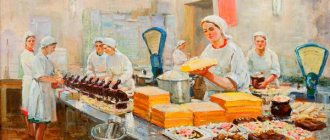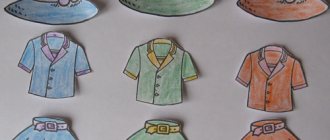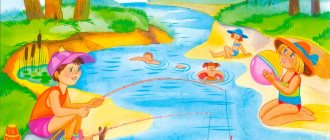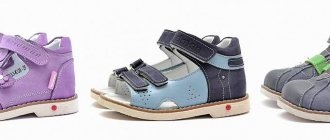How to teach your child to dress independently: 7 useful tips
The ability to dress is important for a child's independence. This activity also helps the child develop fine motor skills (without it you won’t be able to fasten buttons and zippers), coordination (standing on one leg while pulling on pants is not so easy), memory (you need to remember in what order to put on clothes and how to cope with different fasteners), the ability to distinguish between colors and sizes.
After a year, the child can learn to put on and take off socks and shoes. Every year, make the task more difficult for him, teach him to cope with other items of clothing, so that by the age of five the child can dress himself. These simple tips will help your child learn faster.
First learn to take off your clothes
Taking off clothes and shoes is easier and faster than putting them on. Teach your child to immediately take off his shoes and jacket as soon as he comes home. Then teach him to take off his pants (he'll still have to do it himself once he starts pottying). The T-shirt can be a real challenge, but learning to put it on can also be a challenge. Show your child how to first remove the arms from the sleeves and then remove the T-shirt completely.
Practice with suitable clothing
Give your child your clothes or his older siblings' clothes so he can practice and learn procedures on them. Small sleeves and head openings may be more difficult for your baby to get into at first, so larger clothing may be better for training.
Also, for the first lessons, choose T-shirts and shorts. Long sleeves and trousers will only cause the child to get confused. There should be no zippers or buttons on clothes. Or fasten them yourself and teach your child to deal with them later. Correctly matching buttons and loops so as not to skew the entire shirt is a separate art that should be mastered closer to three years.
Explain the sequence of actions
Teach your child to dress independently gradually, explaining each step. First, show in what order you need to put on all the things. Lay out clothes on the bed in this order, so it will be easier for your child to remember.
Teach him how to put on each item of clothing step by step. For example, the hardest part about putting on a T-shirt for a child is getting his arms into the sleeves. At first, hold the T-shirt over the child’s head and ask him to raise his arms to get into the sleeves, but then help him pull the T-shirt on. Once he can do this, allow him to put the shirt on entirely on his own.
Dress while sitting
The child may have gotten used to the fact that he needs to stand while you dress him, because it’s more convenient for you. But it will probably be easier for him to get dressed while sitting and not waste energy trying to keep his balance while he untangles his trouser legs or looks for suitable socks. Encourage your child to sit on the floor or buy him a low chair.
Teach how to put on clothes correctly
Even adults sometimes, due to inattention, put on clothes backwards or inside out, so there is nothing wrong with such a mistake. But it’s better to teach your child to distinguish between sides of clothing. Teach him that clothing size labels should be on the back and inside, but the ropes on his pants and side pockets should be on the front. He can also focus on prints.
Remind your child to look in the mirror when he gets dressed to make sure he is wearing everything correctly.
Choose the right time
Don't start telling your child how to dress when you are in a hurry and about to leave the house. The child will definitely not be able to get ready quickly; you will panic because you are late and end up putting it on yourself anyway.
Learn to dress before going out. If the child begins to be capricious and refuses to get dressed, he will have to change his mind for the sake of a walk. Or turn getting ready into a game. For example, show your child how to put on and take off socks, and then offer to do it for a while or compete with you in changing clothes at speed.
Teach your child to choose clothes
If you are afraid that your child will choose too extravagant outfits, do not immediately leave him alone with all the clothes. First, offer to choose from the two options you selected. Gradually, he will remember which clothes fit best and suit the weather, and will be able to dress without your participation at all.
Read more on the topic
The child wants to choose his own clothes. How can I help him?
“Children should dress like children”: Nicky Hilton criticized modern children's fashion
Mom took her child out for a walk without outerwear and attracted the attention of social networks and law enforcement agencies
Who are we and where can you read us?
After all, we have not only a website!
Lesson summary “Sportswear”
Lesson 15
Topic:
“Sportswear ”
Purpose:
teach to distinguish between clothes for different sports. Instill hygienic requirements for sportswear.
Activating the dictionary:
T-shirt, shorts, socks for football;
gymnastic leotard for gymnastics; swimsuit for swimming; sports pants and jacket for outdoor athletics; ski suit, Equipment:
pictures.
Progress of the lesson:
conversation about sportswear.
Physical education classes are held in the fall, winter and spring, both indoors and outdoors. In the summer (except for rainy days), all classes are organized outdoors, on the physical education ground.
The child must have a special uniform for physical education, which is put on immediately before the lesson and taken off after it.
Clothes should be such that the child feels light, cozy, comfortable, of good quality, clean, dry, made from natural materials, and not restrict movement. Shoes should match the size of the foot, so as not to restrict the leg, be light and comfortable, the sole should be soft and flexible. For indoor classes you must have: T-shirt, shorts, shoes, socks:
Suitable for outdoor activities: tracksuit, leggings, etc. (taking into account weather conditions). The same requirements apply to clothing for outdoor physical education: cleanliness, comfort, suitable size, natural fabrics, etc. Suitable footwear: sneakers, sneakers, moccasins, sports boots, etc. Outdoor shoes should be made of soft materials. Sports shoes should not be too heavy.
During classes, the child should feel light and comfortable.
Didactic game “Assemble a doll for physical education”
Goal: to consolidate children’s ability to dress a doll for physical education, correctly name items of clothing, and put them on in a certain sequence. Raise care for the doll.
Progress of the game: Katya doll is going to play sports. But you need to dress the doll for class in a way that makes it comfortable (i.e., in sportswear).
The teacher invites the children to choose the necessary clothes one by one, specifying the name of the items of clothing and the sequence of dressing. Choose clothes depending on where the activity will be, outdoors or indoors. The Katya doll “reminds” the dressing sequence and “clarifies” the names of clothing items for some children.
Didactic game: “What’s missing?”
Goal: to teach children to remember objects in a group, to determine which one was removed, to develop intelligence, thinking, and memory.
Progress of the game: the teacher places 3-4 objects in a row, invites the children to look at and touch them, etc. Then asks them to close their eyes and removes one object. At a signal, the children open their eyes and try to determine what is missing.
Lesson on speech development in kindergarten. Senior group. Topic: Clothes
Summary of a lesson on the development of children's speech in the senior group on the topic: “Clothing”
Program objectives Educational: Continue to teach how to describe items of winter clothing Continue to teach to correctly answer the teacher’s questions with a complete answer Developmental: Clarify and systematize children’s ability to distribute clothes according to the seasons (Winter, summer) Educational: To develop a caring attitude towards clothing. Vocabulary work: Ancient man, winter, spring, summer, autumn, clothes, parcel, fur coat, hat, boots, scarf, mittens Materials and equipment: Envelope with the image of an ancient man, parcel, pictures depicting clothes at different times of the year, Preliminary work: Educator: writing notes, preparing material and equipment Children: Conversation on the topic of clothing, looking at illustrations depicting clothes, solving riddles “Clothing” Methodology Stages Contents Note Introductory part Educator : Guys today, when I went to kindergarten, I found K an envelope , do you want to know what's there? Let's quickly open it and see what's there. Educator : Look who is depicted in the picture? Children: An ancient man Educator : That's right, guys, this is an ancient man. He asks us to help him and tell him how to dress in the cold season. Children are sitting at tables
. I show the envelope, open it with the children, and pay attention to the image of an ancient man.
Main part. Educator: - B In ancient times, people lived in caves and made clothes from animal skins. - What do you think, if you and I were wearing such clothes now, what would happen to us? Children: Frozen / Educator: - Why would we freeze? Children: Because it’s cold outside now. Educator: That's right, guys. Late autumn has arrived. — If you met a person dressed in clothes made from animal skins, what would you advise him to wear in order not to freeze? Children: Jacket, boots, hat, mittens, scarf Educator: - Now guess what I suggest our primitive man wear. I’ll tell you riddles, and you guess Five fingers, like people’s, but her fingers have no nails. (glove) I walked along the road, I found two roads, I followed both. (Pants) House for the head. (Hat) It’s black, not earth, fluffy, not snow, warms, not a stove. Fur coat Educator: Well done guys, you guessed everything correctly, do you think a person will become warmer if he puts on these clothes? Children: yes. Educator: Now let's get up from the tables and rest a little. Winter has come. It's getting cold. (we spread our arms to the sides, cross them on our chests) Oh, yes. Oh, yes, yes. We are not afraid of the cold. (We clap the rhythm with our hands) So that our feet do not freeze, We put on boots (we alternately place our feet forward on the heel) Oh, yes. Oh, yes, yes. We are not afraid of the cold. (we stamp the rhythm with our feet) Hat, help us out, warm our ears. (rubbing our hands over our ears) Oh, yes. Oh, yes, yes. We are not afraid of the cold. (clap the rhythm with our hands) To warm our hands, we need to put on mittens. (imitates putting on mittens) Oh, yes. Oh, yes, yes. We are not afraid of the cold. (clap the rhythm with our hands) We’ll put on a new jacket and warm pants. (imitation of putting on a jacket and pants) Educator: Guys, what is the name of the clothes that we put on in winter? You need to answer in full Children: In winter we put on winter clothes Educator: That's right, but in the spring? Children: In the spring we put on spring clothes Educator: Well done, guys, and when summer comes, what clothes will we wear? Children: In the summer we wear summer clothes Educator : And in the fall? Children: In the fall we put on autumn clothes. Teacher : so we had a rest, and now let's play an interesting game. Did. Game “winter, summer” Purpose: To develop in children the skills of distributing clothes by season Educator: And now I suggest you divide clothes into winter and summer. Now everyone will come up to me and take a picture with a picture of clothes, you will need to attribute it to the right time of year.. Where winter clothes are shown we will put them in a parcel for an ancient person, and where summer clothes are shown we will put them aside Educator : Well done guys, they all coped well with the task Conversation on the topic “Clothing”. Educator: Please look at the board. What do you see on it? Children: Winter clothes Teacher: That's right, I will show you a picture of clothes and ask a question For example: “What kind of coat is this? (winter, warm). And you must answer with a complete answer. Everyone understood the task. Children: yes. Teacher: then let’s start completing it. What kind of jacket? (fur). What colour? What does the coat have? What does the jacket have? (collar, sleeves, pockets, buttons). What is a scarf for? (so that it is warm, so that it does not blow, so that the cold does not creep up your neck). About what we say “fluffy”, “fur”, “soft” I begin my story. I achieve logical thinking in children. I listen to the children's expected answers. each child who guessed goes to the table, finds the clothes they guessed, puts the shoes in a box (parcel) I praise the children I give a physical education lesson
Children imitate movements during the poem I ask children questions I encourage them to answer correctly with a complete answer I conduct a didactic game “Winter, Summer” Illustrations of winter clothes are on the board . I draw attention to the fact that children name color, individual qualities, and purpose. I ask several children. Final part. Teacher, well done guys, everyone turned out to have very good stories, he now knows how to dress correctly in the winter season. Guys, let's remember what we talked about today? Children: about clothes Teacher: what clothes do you know? Children: Jacket, fur coat, hat, boots, mittens, scarf Educator: Correct, what is the name of the clothes we wear in winter? Children: Winter clothes Educator: What about the clothes we wear in the summer? Children: Summer clothes Educator: Guys, for helping the Ancient Man, he sent you each a medal. I praise the children, We remove everything, I give medals to the children.
Download Summary of a lesson on speech development for children in the senior group on the topic: “Clothing”
We recommend watching:
Notes for a lesson on speech development in the senior group: Special purpose transport Notes for a lesson on speech development for children in the senior group of preschool educational institutions Notes for the development of speech in the senior group “Wild Animals of Russia” Notes for a lesson on speech development in the senior group. Nosov "Gardeners"
Similar articles:
Summary of a lesson on speech development in the senior group. Compiling a descriptive story based on a painting
Summary of a lesson on speech development in the senior group. Reading works of fiction
Summary of a lesson on speech development in the senior group. Retelling of a work of art. Charushin "Sparrow"
Summary of a lesson on ecology in the senior group of kindergarten on the topic “Man and Nature”
Lesson on emotional development in the senior group







